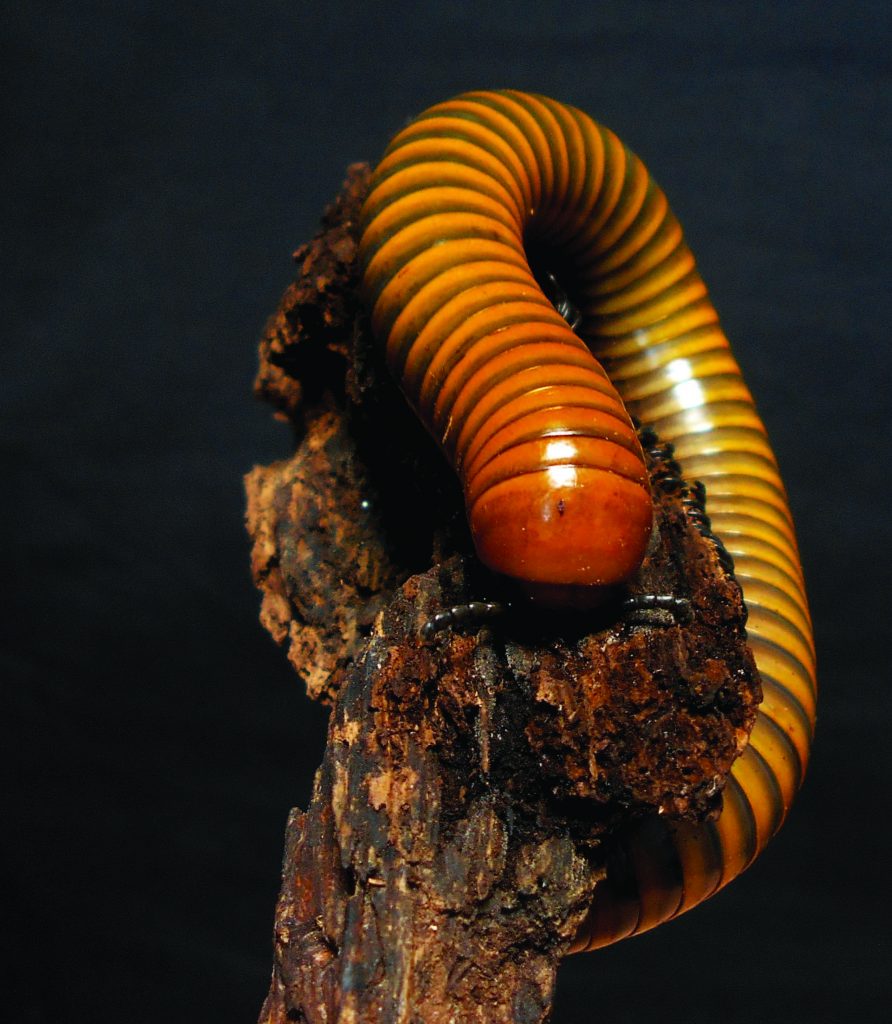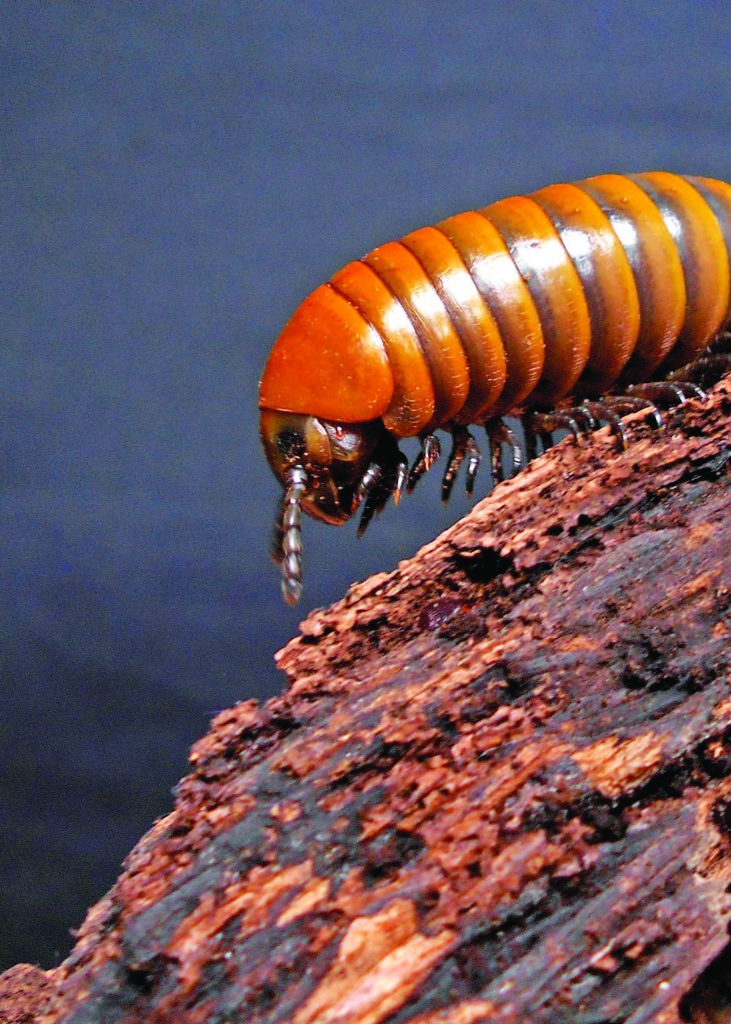Apart from phasmids, perhaps one of the more underrepresented of the local invertebrate subcultures is that dealing with millipedes, an anomaly possibly attributed to a lack of availability and diversity rather than an absence of interest.
The rather common Philippine Flameleg (Trigoniulus macropygus) sometimes finds its way in specialist collections, but extremely little is known about the representation of other species in captivity.
Nevertheless, this ancient group of animals only requires a very straightforward care regimen, and even novices, kids including, can successfully rear specimens with just some basic considerations.
However, the species covered in this paper is one of the more defensive millipedes I am aware of and thus is better suited to more advanced hobbyists — but that doesn’t make it necessarily more difficult to keep than the other, more inoffensive ones. The main difficulty is obtaining sources of captive-born stocks.

I first found these animals while on a trek in Oriental Mindoro about ten years ago. On subsequent visits, I found these millipedes to be easily observed, albeit not at all common, and only quite recently have been given the opportunity to maintain three specimens. As of this writing, I must admit that I have not pinned down the exact identity of the animals, and possible candidates for its generic identity rests in the genera Acladocricus, Spirobolus, or Thyropygus. A similar, if not the same, species is purportedly found in Cebu.
Hydration and heat
Spraying the animals with dechlorinated water from two to three times a week ensures that humidity levels remain acceptable. Being animals of high rainfall areas, frequent deluges are commonplace, although one must ensure there is sufficient ventilation within the cage, or molds and pathogens may run amok and overwhelm the inhabitants.
While millipedes can sometimes be seen drinking droplets of water delivered through mist spraying, a shallow bowl of fresh water should be incorporated as this allows them to drink as much as they want, whenever they want; in my enclosure, I change the water about thrice a week, each episode entailing the thorough washing of the receptacle instead of merely filling it with water from above.

Average diurnal temperatures of 23 degrees Centigrade and nighttime lows to 16 degrees Centigrade is adequate. If the prevailing temperatures around the enclosures swing from 28 degrees upwards, the effects can somewhat be negated by providing a larger enclosure with deeper substrates and more frequent spraying, although simply moving it to a cooler spot is much more straightforward. Temperatures that regularly reach from the low to mid 30s will prove detrimental, even in the short run.
Description and habitat
These large millipedes are typically 17 centimeters in length with a girth of 1.4 centimeters. The ground color is ochre yellow, with the anterior margins of the plates being dark or olive gray, thus presenting a banded appearance. Appearance-wise, these are similar to the Chinese Spirobolus walkeri and S. bungii, though in very mature specimens, the amount of yellow coloring decreases and the darker shade predominates; under bright lighting, the dark bands can appear slate blue. The legs and antennae are jet black. Prior to molting, the coloration wanes into a dingy shade.
Whereas many millipede species curl up when disturbed, the Mindoro Giant will bow their heads downwards and expel a noxious chemical to deter perceived threats. These foul-smelling ejecta should be especially effective against potential predators that try to grab a mouthful of millipede prey. Most millipedes possess hydrogen cyanide — infamously used by the Nazis for their Zyklon-B gas chambers — but other chemicals are also known to be produced. Due to the scarcity of studies done on millipede chemical defenses and the uncertain identity of the species at hand, I would not pretend to know exactly the type of secretion that this millipede uses.
In common with many other large species, the Mindoro Giant calls the limestone forests its home. Limestone is rich in calcium carbonate, which plays an important role in the maintenance of millipede armor. These animals are crepuscular and nocturnal, foraging out in the open in search of food or potential mates. Perhaps due to their defensive nature, these millipedes are more apt to wander off into the open and even on road cuts, even when the sun still has not set. In comparison, other species from other genera will usually stay on rock walls and debris, and will often venture out in the open only when it is dark.
I have only observed this species in Oriental Mindoro at an altitude of about 370 meters in limestone forests. They prefer a very narrow altitudinal band, only within the vicinity of limestone rocks. Cool breezes constantly flow in their preferred habitat and it quickly dissipates whatever heat is generated through open gaps in the forest.

Husbandry
A trio of these millipedes can be comfortably housed in a standard 5 gallon tank, although one that has a 10 gallon capacity allows the keeper to put more naturalistic decorations. Like other millipede species, they should be provided with a substrate deep enough to allow not only just burrowing, but also a choice of microclimates and humidity and temperature gradients. A substrate layer that is sufficiently deep has strata of varying levels of moisture content, with the lowermost layers being the most damp and therefore the coolest temperature-wise, while the topmost stratum is the driest and warmest.
Animals of the forest floor, particularly those that live a wholly- to part-subterranean lifestyle, should be permitted to select depths of their choices, as doing so allows them to seek comfort and insulate themselves from the vagaries of the prevailing climate. A soil layer consisting of mostly leaf mould, bark, and twigs from two to three inches deep is adequate.
Another benefit of a deep soil is that it allows the millipedes to burrow during the molting process. If possible, try introducing springtails (Collembola spp.) into the soil as these can help maintain the health and balance of enclosures using organic-based substrates. Millipedes, in particular, can generate relatively large amounts of waste, and pellets can become moldy in damp conditions if these do not decompose fast enough.
Millipedes are extremely easy to feed, and one of the things I find so cool about them is that they will even eat whatever is in their substrate, as long as you are providing them with the correct one. They will eat decomposing plant matter, even wood, in their enclosures, although it would be best to present other food items to meet a well-rounded diet, and this is easily accomplished by introducing pieces of fruit and vegetable refuse and peelings; apple core is a particularly relished treat, as are carrot bits, cucumber, and the succulent petioles of pechay.
These are animals that would never require you to spend even a centavo for their food. Still, I must warn you not to try and feed them mango peelings due to their caustic nature. Except for oranges, foods that are rich in oxalates, such as spinach, taro leaves and corms, should be eyed with suspicion, although the oxalates present are likely partly to wholly lost as the leaves start decomposing.
I’ll go even further: edible members of otherwise notoriously poisonous plant families, such as lychee, rambutan (family Sapindaceae), and cassava (family Euphorbiaceae) may be poor food choices, although potatoes and tomatoes are definitely acceptable despite belonging to the infamously deadly nightshade family Solanaceae. Sure, the millipedes may themselves avoid eating what to them may be laden with treacherous chemicals, but one cannot discount the possibility that such plants may introduce toxins into the enclosures.
Interest

The Mindoro Giant Millipede provides an interesting addition to an invertebrate collection and fits well in a menagerie dominated by arachnids. They are unusual enough to command attention (or revulsion, depending on the nature of who is looking) and are large enough to impress the heck out of anyone.
Compared to many other giant species which are mostly plain black, the Mindoro Giant is quite colorful; if they were a mainstay in the invertebrate hobby, they may be one of the more popular species due to coloration alone. But as it currently stands, they are one of the rarest species in captivity and I may not be exaggerating if I say that a one-armed man can easily count using his fingers the total number of people who maintain this species.
Handling
Compared to their venomous and predatory cousins, the centipedes, millipedes are far more innocuous. Instead of biting, they resort to curling when agitated to protect the more vulnerable undersides. However, in some species, the defensive repertoire is much more pronounced and involves the spraying of cyanide behind the head. Perhaps not surprisingly, millipede species that do so will rarely, if ever, curl up. Such is theirfaith in the effectivity of their deployment of their chemical weapons.
Incidentally, the Mindoro Giant is one of the more defensive species, and some individuals are quick to spraying their noxious brew when abruptly handled. I have never had a skin reaction to these staining sprays, although it is possible that some people may prove sensitive enough for their skin to react otherwise.
What to do when a millipede sprays on you
In the event that a Mindoro Giant sprays noxious chemicals, it is advisable to simply wash the hands thoroughly in running water until the chemical has cleared, instead of using soap or alcohol — the chemicals in soap and alcohol may react with cyanide in an unwelcome manner.
Nevertheless, it is possible to safely handle millipedes if they are picked up very gently and allowed to crawl into your hand. In these circumstances, these animals indeed prove to be calm and tractable creatures.
This appeared in Animal Scene magazine’s May 2019 issue.





